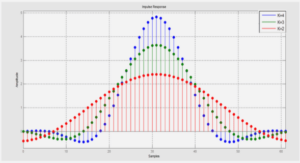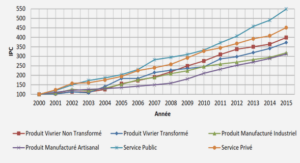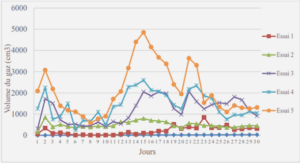Introduction
Cette thèse présente divers résultats théoriques et numériques concernant le modèle de Hartree-Fock-Bogoliubov qui permet la description de systèmes fermioniques attractifs. Un problème important est de savoir si la matrice d’appariement est non nulle pour les systèmes attractifs, pour l’état fondamental, lorsque le nombre moyen de particules est fixé. La non-nullité de cette matrice est supposée décrire des phénomènes physiques comme l’apparition des paires de Cooper, que l’on retrouve en physique de la matière condensée et en physique nucléaire, et qui est reliée à la supraconductivité et à la superfluidité. Dans le cas où la matrice d’appariement serait nulle, on retrouve le modèle de Hartree-Fock utilisé dans de nombreuses applications mais qui ne permet pas la description de ces phénomènes. Nous décrivons ci-après les résultats obtenus dans les divers chapitres de la thèse.
Algorithmes et analyse de leur convergence
Dans le chapitre 3, nous étudions la convergence des algorithmes de Roothaan et ODA, utilisés pour résoudre le problème de minimisation de l’énergie de HartreeFock-Bogoliubov. Ils ont largement été étudiés par É. Cancès et C. Le Bris pour la résolution des équations de Hartree-Fock en chimie quantique, mais pas pour les systèmes attractifs comme dans cette thèse. L’algorithme de Roothaan est un simple algorithme de point fixe sur l’équation non linéaire (0.0.5), qui n’assure a priori pas la décroissance de l’énergie. Nous donnons tout d’abord une définition du caractère bien posé de cet algorithme,et démontrons ensuite un théorème concernant ses problèmes de convergence et dont la preuve repose sur de récents travaux d’A. Levitt. En effet il se peut que l’algorithme oscille entre deux états dont aucun des deux n’est solution du problème de minimisation HFB. Pour comprendre ce phénomène, nous introduisons une fonctionnelle d’énergie à deux variables
E˜(Υ, Υ′) := Tr(hG) + Tr(hG′) + 2 Tr(G J(G′)) − Tr(G K(G′)) + Tr(A K(A′)), en suivant É. Cancès et C. Le Bris
Roothaan vs ODA
In the HF case, we have observed that the Roothaan algorithm very often oscillates between two states, none of them being the solution of the problem (as described in Theorem 3.1.1 and in [7]). The Roothaan algorithm seems more well behaved in the HFB case. With the model presented in this section, we never got real oscillations for HFB. Sometimes the convergence is improved by using the ODA,but in most cases the Roothaan algorithm always converges towards the same state as the ODA in the end. We start by comparing Roothaan and ODA in the HF case. There, oscillations seem to be related to the size of the gap between the largest filled eigenvalue and the smallest unfilled one. Indeed, oscillations in HF seem to only occur when there is pairing in HFB, an effect which is also well-known to be related to the size of the gap (see, e.g., Theorem 5 in [2]). When there is no pairing, the HF Roothaan algorithm always behaves like the ODA. However, the situation is complex and there is no exact rule. Sometimes the Roothaan algorithm does not oscillate even when the gap is rather small and there is pairing. In Figure 4.1 we display the value of the energy obtained along the algorithm for the Roothaan and the ODA, for the following choice of parameters: N = 6, Nb = 200, ℓmax = 0 and rmax = 30. The ODA converges in about 17 iterations, whereas the Roothaan algorithm oscillates. We also show the value of the norms ||Gn − Gn−1|| and ||Gn − Gn−2|| along the Roothaan algorithm. The oscillation between two points is clearly demonstrated.
Dependance on the initial state
We want to prove numerically that the convergence of the ODA algorithm does not depend on the initial state. In all the previous numerical computations, the initial generalized one-body matrix Γ was a multiple of the identity. To show that the convergence does not depend on the initial state, we chose randomly 100 initial matrices Γ and ran the algorithm for each of them. In figure 4.6, each curve represents the relative error between the energy of the state along the iterations of the ODA, and the reference energy (obtained with the identity matrix as initial state). The relative error is plotted in logarithmic scale. Both in the HF and HFB cases, we can see that the energy decreases during the algorithm in the same way whatever the initial random state. We also cheked that the final state was always the same. The relative error which we found for the final state was of the order of 10−7 for all the simulations, which was our chosen convergence precision.
|
Table des matières
Remerciements
Introduction (FR)
I Theory
1 Hartree-Fock-Bogoliubov model for attractive systems
1.1 Linear N-body Schrödinger model
1.1.1 Many-body wavefunctions
1.1.2 Basis of the N-body spaces, tensor products
1.1.3 The N-body Hamiltonian
1.2 Hartree-Fock approximation
1.3 Second Quantization
1.3.1 Fock spaces
1.3.2 Creation and annihilation operators
1.3.3 Observables
1.3.4 Quasi-free states
1.4 Hartree-Fock-Bogoliubov theory
1.4.1 Hartree-Fock-Bogoliubov states and their energy
1.4.2 Rigorous definition of the HFB energy
1.4.3 Existence results and properties of minimizers
2 Discretization
2.1 Convergence analysis
2.2 Discretization of the HFB model
2.3 Using symmetries
2.3.1 Time-reversal symmetry
2.3.2 Rotational symmetry
2.3.3 Discretization of the radial HFB problem
3 Algorithmic strategies and convergence analysis
3.1 Roothaan Algorithm
3.2 Optimal Damping Algorithm
3.3 Handling constraints
II Numerical simulation of some real systems
4 Non relativistic gravitational systems
4.1 Model
4.2 Method
4.3 Numerical results
4.3.1 Roothaan vs ODA
4.3.2 Numerical evidence of pairing
4.3.3 Properties of the HFB ground state
4.3.4 Quality of the approximation in terms of Nb
4.3.5 Dependance on the initial state
4.4 Comparison with Thomas-Fermi
4.4.1 Estimate of ITF using the Hardy-Littlewood-Sobolev inequality
4.4.2 Numerical calculation of ITF
5 A simplified model for protons and neutrons
5.1 Model
5.2 Some computational details
5.3 Slow convergence and oscillations of Roothaan
5.4 The critical intensity
Bibliography
![]() Télécharger le rapport complet
Télécharger le rapport complet





